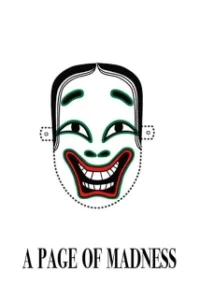Lost and Found Genius: How 'A Page of Madness' (1926) Unleashed Japanese Avant-Garde Cinema's Wildest Dreams!
In the electrifying, experimental atmosphere of 1920s cinema, while Western filmmakers were developing their own unique languages of expressionism and surrealism, Japanese cinema was quietly forging its own revolutionary path. Yet, much of this vibrant period remains tragically lost, with many films from the era surviving only as fragments or, in many cases, vanishing entirely. One monumental exception, a recovered masterpiece that defied conventional storytelling, is Teinosuke Kinugasa's A Page of Madness (1926), or Kurutta Ippeiji. This film is a foundational pillar of Japanese avant-garde cinema, an astonishing work of visual poetry that obliterated traditional narrative structures and plunged directly into the tormented psyche of its characters. Its innovative cinematography, rapid-fire editing, and profound psychological depth make it a crucial historical artifact, revealing the audacious artistic courage of early Japanese filmmakers and proving that cinema could be a powerful, unsettling medium for inner exploration.
The film plunges us into the disorienting, claustrophobic world of a mental asylum, where a former sailor (played by Masuo Inoue) takes on a janitorial job, not out of necessity, but to be close to his wife (Yoshie Nakagawa), who is an inmate there. Her madness is a result of a traumatic event – the drowning of their child – for which she was blamed, and he seeks to understand, perhaps even to liberate, her. What unfolds is not a linear plot, but a chaotic, subjective kaleidoscope of fragmented memories, vivid hallucinations, and the blurring lines between sanity and madness, both within the asylum's walls and in the minds of its inhabitants. Kinugasa's vision is one of profound empathy for the institutionalized, portraying their suffering and their inner lives with a raw, often disturbing, emotional intensity, devoid of dialogue, relying entirely on visual language to convey its harrowing narrative.
Teinosuke Kinugasa's direction is a tour de force of experimental filmmaking, employing techniques far ahead of its time. The film is a masterclass in subjective camera work, expressionistic lighting, multiple exposures, superimpositions, and rapid, disorienting editing that perfectly mirrors the fractured mental states of its characters. The visual language is rich with symbolism and psychological depth, transforming the asylum into a labyrinth of the mind. The absence of traditional intertitles (though it was screened with a live narrator, or benshi, in Japan) forces the audience to engage with the visuals on a purely emotional and intellectual level. A Page of Madness is a visceral, unsettling, and ultimately profoundly moving experience, a testament to the power of pure cinematic artistry and a director unafraid to explore the darkest corners of the human psyche.
A Page of Madness was famously considered lost for over 45 years until Teinosuke Kinugasa himself rediscovered a print in his own storehouse in 1971. This remarkable recovery allowed audiences worldwide to finally experience this groundbreaking work. The film was made as an independent production, outside the mainstream Japanese studio system, allowing for its radical experimental nature. Masuo Inoue as the Husband and Yoshie Nakagawa as the Wife deliver powerful, physically expressive performances, crucial for a silent film of this intensity. It remains a cherished cult film and a vital piece of cinematic history, offering a rare and electrifying glimpse into the avant-garde spirit of early Japanese cinema.
Director: Teinosuke Kinugasa.
Cast: Masuo Inoue as The Father/Sailor, Yoshie Nakagawa as The Wife, Ayako Sano as The Daughter, and Hiroshi Nemoto as The Daughter's Lover.
Special Info/Trivia: The film was considered lost for over 45 years until director Teinosuke Kinugasa rediscovered a print in 1971. It is a seminal work of Japanese avant-garde cinema. The film was made without intertitles, relying solely on visual storytelling and, in its original Japanese release, a live benshi (narrator). It explores themes of madness, psychological trauma, and institutionalization with a highly experimental style.

